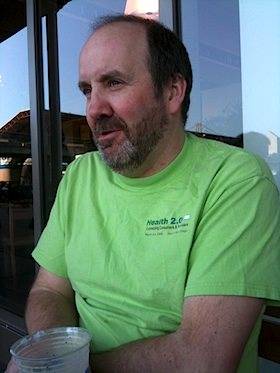It’s a sunny afternoon in San Francisco and health care is in the air. I’m sitting at the the Peet’s in the SF Ferry Building eating a vegan ginger cookie and waiting for Matthew Holt, founder of The Health Care Blog and the leader of Health 2.0 conference to show up for an interview. He arrives wearing shorts and a Health 2.0 t-shirt, and has his dog with him. He tells me he jogged to our location on the bay from Health 2.0 headquarters seven minutes away. It’s a beautiful day – and here in the United States, the health care reform bill just passed.

ReadWriteWeb’s founder and leader, Richard MacManus, joins us, and we dive into a conversation on the revolution underway in cloud, mobile, and social health tools. By the end of the day, we were left with one question: Will health care reform build a health Internet, or will entrepreneurs do it because they can?
A Brief History
One nice thing about profiling the thoughts of bloggers is that they leave a trail to track them down.
Here are a few of Holt’s social and technology posts on The HealthCareBlog:
- A new campaign against childhood obesity
- Aneesh Chopra on txting in Haiti
- PatientsLikeMe buys ReliefInSite
Here are a few of MacManus’ posts at ReadWriteWeb that track to health care:
- McKinsey: Get Ready For Sensor-Driven Business Models
- iPhone Apps For The Masses: Health & Fitness
- Health 2.0 Through the Eyes of a Diabetic – One Year Later
Health Care Reform is like Ice Skating in San Francisco
A phenomenon I see every year in San Francisco in December is the setup of the ice-skating rink. Palm trees and skaters. For children and adults alike, it’s a way dream about a past and present, whether real or fiction.

And, yet, while good for humanity, something about it doesn’t quite hold the spirit of the pristine pond and cabin by the lake. We know, even though the ice is icy, generators are pumping along the edges. It’s not quite pristine, and it’s not quite ours.
That’s how health care reform feels – a victory indeed – but for some reason not a personal win. Somehow, reform feels artificial and hard to grasp. A small part inside of me wants to scream out, “is there an app for that”?
Is it One Big Health Cloud?
To get the conversation started, I asked Holt and Macmanus, “What is your take on cloud computing for healthcare?”

Holt asked in return, with a grin, “What exactly is the cloud? Is it a thing, or is it a collection of services that are connected together?”
We discussed this question in practical terms
Holt: “Here’s a question: Will Salesforce’s cloud be merged with other organizations’ contacts, and will we have shared controls? Is that the difference between cloud computing and SAAS?”
We came back to our business, blogging. Blog software like Moveable Type (RWW) and WordPress (The Health Care Blog) generate common feeds in simple formats (RSS) that can be used and mashed up in all sorts of ways. But, that doesn’t mean that MT and WordPress themselves are hot swappable, as there are controls, widgets, and other tools that are optimized in the application layer.
Perhaps, in this way, EHR (Electronic Health Record) systems can be thought of as a blogs, where people are the categories, and events are the posts. If so, what is needed for health care information exchange is a basic feed for key members of the exchange: doctors, patients, pharmacies that connects new systems on top of it.
For health care exchange, connecting patients is so much more than connecting infrastructure, platforms or software. Like all good software, it’s about finding the shortcut. We should endeavor to find, build, and monetize the simplest exchange that will drive the future generations of meaningful interoperability.
As we spoke, a light turned on.
Is Health Part of the Internet of Things?
Macmanus: “Health devices are one of my favorite use cases for the Internet of Things. Let’s take the example of a blood pressure monitor. It’s a portable device that augments your life and well being, and the promise of connecting to other things and streams is real”.

Holt: ” …and look at medical devices closer – we see they are intelligent, self adjusting, and include feedback loops and reminders. These devices are starting to connect to the Internet and to people.” “And what about the Wii,” he continued. “The Mii is already virtual me, and the WiiFit is compelling and network enabled”.
All of us noted that Nike’s work in this area is inspiring – from ease of use to business model implications, there is something great going on with the Nike + sensor and the company’s broader ambitions.
We realized that technology has already started a revolution in health – and it’s getting traction.

Macmanus: “I’m fresh from SXSW and have location on my mind. We heard that FourSquare is at work on a next-generation feature on websites, where checking in will connect virtual and real worlds. Also, with innovations like self-tagging StickyBits and Microsoft Tag floating around, real-world augmentation is starting to take form and connect with the Internet world.”
Holt: “UPC tag scanners, such as mobile phone bar code readers like ScanAvert connect real world things to facts about them, such as ingredient and nutrition information.”
We were reminded of the Quantified Self movement. This is a meetup that has growing momentum in the SF Bay Area and around the country. It is a place where self-reporters get together and share war stories.
Organized by Gary Wolf and Kevin Kelly, it combines what’s on the cutting edge and our overwhelming fascination of creating a digital diary through logging data about oneself. And, best of all, the meetings focus on “What did you learn about yourself,” which focuses the meetup on us, not just technologies or business models. We learn that our motivations matter.
Let’s Run it All on Amazon and Get Scale
The tools are ready, entrepreneurs are on board, and we all believe that the cloud is here.
But, what about the data?
That is a tougher question, and a familiar storyline of permissions, identity, matching, EDI, XML – it’s enough to make you sick considering all of the potential work to align it all.
In the spirit of the shortcut, the three of us came up with an idea: What if instead of connecting all of the hospitals, instead we connected every person in the U.S.? What if we would each have a server in the cloud, tuned to receive and share our own health transactions? This health server on the network would run software to receive files, add streams and connect devices under our direct control.
The three of us did a bit of back of napkin work and believe that we could outsource the entire thing to Amazon for about US $1 billion yearly. This would cover server fees and data access for every American to have their own instance of server optimized for transmitting health information
Here’s our math:
300 million people [multiplied by base fee of $30.00 per year multiplied by the .1 concurrent utilization rate. Build a cloud architecture that reduces the cost by 10 times by leveraging computing systems that spin up on demand and therefore dramatically reduce physical costs.
We think this type of math, however crude (and perhaps wrong), is worth thinking about as we spin up the servers for health care reform.
We’re Convinced: People Eat, Sleep, Pirouette, Take Pills
By the end of our conversation, Macmanus, Holt and I were left with an invigorating idea about the new health care reform: It isn’t a thing, it’s a moment in time.
Innovations for health care are already springing out of the Web and will thrive on their own merits, so the job of health care reform technology should be to instigate this innovation, stat.
What would you do if offered a fixed bid contract for $1 billion annually to build a new health cloud for America?
Who would you bring along to get the work done?
Photo credit: abhijittembhekar










